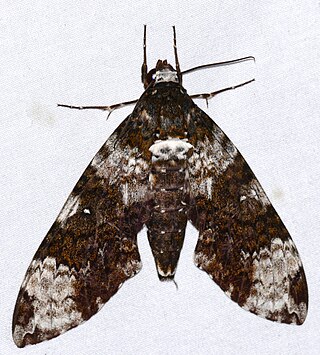
Manduca albiplaga, the white-plaqued sphinx, is a moth of the family Sphingidae. It was first described by Francis Walker in 1856.

Ceratomia amyntor, the elm sphinx or four-horned sphinx, is a North American moth in the family Sphingidae. The species was first described by Carl Geyer in 1835. It has a wingspan of 3+1⁄4-4+1⁄2 inches. As the name suggests, the larvae (caterpillars) feed on elm trees (Ulmus), but they can also be found feeding on birch (Betula), basswood (Tilia), and cherry (Prunus). When the caterpillars are ready, they crawl to the bottom of the host tree, where they crawl underneath the soil and pupate and may overwinter underground if late enough into the year. Vegetable growers should be aware of this larvae due to its insatiable appetite. One of these larvae are capable in devouring huge amounts of plant's foliage and even succulent stems.

Sphinx chersis, the great ash sphinx or northern ash sphinx, is a moth that belongs to the family Sphingidae.

Paonias excaecata, the blinded sphinx, is a moth of the family Sphingidae. The species was first described by James Edward Smith in 1797.

Sphinx libocedrus, the incense cedar sphinx, is a moth of the family Sphingidae. The species was first described by Henry Edwards in 1881. It ranges from the western Texas to southern California and Mexico.
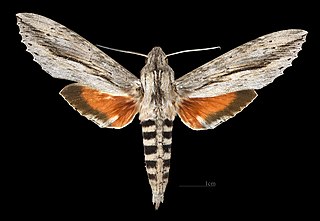
Erinnyis ello, the ello sphinx, is a moth of the family Sphingidae. The species was first described by Carl Linnaeus in his 1758 10th edition of Systema Naturae. It is distributed from Argentina through Central America to the United States as far north as Nevada.
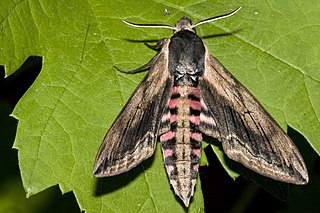
Sphinx ligustri, the privet hawk moth, is a moth found in most of the Palearctic realm. The species was first described by Carl Linnaeus in his 1758 10th edition of Systema Naturae.
Pachysphinx modesta, the modest sphinx or poplar sphinx, is a moth of the family Sphingidae. The species was first described by Thaddeus William Harris in 1839.

Aellopos clavipes, also known as the clavipes sphinx, is a moth of the family Sphingidae.
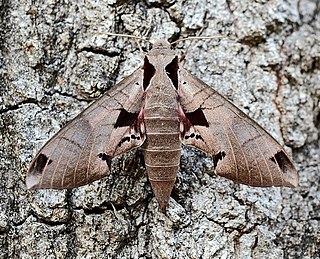
Eumorpha achemon, the Achemon sphinx, is a moth of the family Sphingidae. The species was first described by Dru Drury in 1773.

Eumorpha typhon, the Typhon sphinx, is a moth of the family Sphingidae. The species was first described by Johann Christoph Friedrich Klug in 1836.
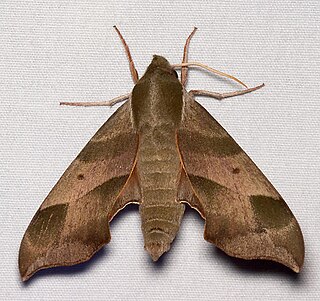
Darapsa myron, the Virginia creeper sphinx, is a moth of the family Sphingidae found in central and eastern North America.

Deidamia inscriptum, the lettered sphinx, is a species of moth of the family Sphingidae. It is the only member of the genus Deidamia. The species was first described by Thaddeus William Harris in 1839 and the genus was erected by James Brackenridge Clemens in 1859.

Theretra japonica is a moth of the family Sphingidae first described by Jean Baptiste Boisduval in 1869.

Darapsa choerilus, the azalea sphinx, is a moth of the family Sphingidae first described by Pieter Cramer in 1779. It is found in the United States and southern Canada east of the Rocky Mountains.

Darapsa is a genus of moths in the family Sphingidae first described by Francis Walker in 1856.
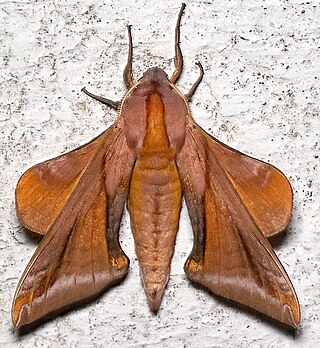
Paonias astylus, the huckleberry sphinx, is a moth in the family Sphingidae. The species was first described by Dru Drury in 1773.
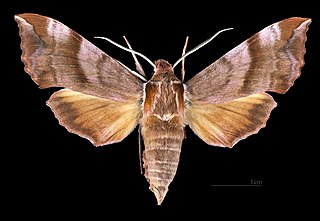
Clarina syriaca is a moth of the family Sphingidae. *

Decodon verticillatus, the sole species in the genus Decodon, is a flowering plant in the family Lythraceae. It is commonly known as waterwillow or swamp loosestrife. It is native to wetlands in the eastern half of the United States and Canada.


















